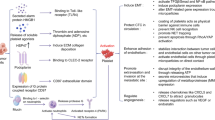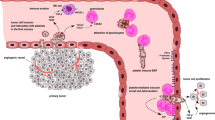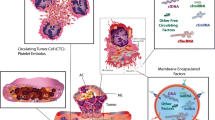Abstract
Hematogenous metastatic spread of cancer is strongly dependent on and triggered by an intensive interplay of tumor cells with platelets. Immediately after entering the blood vascular system, tumor cells are surrounded by a platelet cloak, which protects them physically from shear stress and from attacks by the immune surveillance. Furthermore, tumor cell binding activates platelets, which in turn release growth factors and chemokines to recruit myeloid cells into the platelet/tumor cell microemboli, eventually create a permissive microenvironment in the early metastatic niche. Although the molecular mechanisms of tumor cells to activate platelets appear versatile being a matter of further research, interference with platelet activation turns out to be an attractive target to efficiently inhibit tumor metastasis. Some experimental assays are generally recognized to follow tumor cell-induced platelet activation (TCIPA), which provide an insight into the molecular mechanisms of TCIPA and allow searching for potential inhibitors. In this chapter, we describe the two most prominent experimental assays to follow TCIPA, namely platelet aggregation and platelet granule secretion, experimentally realized by dense granules´ ATP quantification. Although light transmission aggregometry and ATP detection from dense granule secretion are two age-old techniques, they are still highly relevant to provide reliable information concerning platelet activation status since all tumor cell-derived molecular triggers are covered and monitored in the experimental outcome.
Access this chapter
Tax calculation will be finalised at checkout
Purchases are for personal use only
Similar content being viewed by others
References
Semple JW, Italiano JE, Freedman J (2011) Platelets and the immune continuum. Nat Rev Immunol 11:264–274. https://doi.org/10.1038/nri2956
Franco AT, Corken A, Ware J (2015) Platelets at the interface of thrombosis, inflammation, and cancer. Blood 126:582–588. https://doi.org/10.1182/blood-2014-08-531582
Gay LJ, Felding-Habermann B (2011) Contribution of platelets to tumour metastasis. Nat Rev Cancer 11:123–134. https://doi.org/10.1038/nrc3004
Labelle M, Hynes RO (2012) The initial hours of metastasis: the importance of cooperative host-tumor cell interactions during hematogenous dissemination. Cancer Discov 2:1091–1099. https://doi.org/10.1158/2159-8290.CD-12-0329
Li N (2016) Platelets in cancer metastasis: to help the “villain” to do evil. Int J Cancer 138:2078–2087. https://doi.org/10.1002/ijc.29847
Schlesinger M (2018) Role of platelets and platelet receptors in cancer metastasis. J Hematol Oncol 11:125. https://doi.org/10.1186/s13045-018-0669-2
Kopp H-G, Placke T, Salih HR (2009) Platelet-derived transforming growth factor-beta down-regulates NKG2D thereby inhibiting natural killer cell antitumor reactivity. Cancer Res 69:7775–7783. https://doi.org/10.1158/0008-5472.CAN-09-2123
Maurer S, Kropp KN, Klein G et al (2018) Platelet-mediated shedding of NKG2D ligands impairs NK cell immune-surveillance of tumor cells. Onco Targets Ther 7:e1364827. https://doi.org/10.1080/2162402X.2017.1364827
Placke T, Kopp H-G, Salih HR (2011) Modulation of natural killer cell anti-tumor reactivity by platelets. J Innate Immun 3:374–382. https://doi.org/10.1159/000323936
Lowe KL, Navarro-Nunez L, Watson SP (2012) Platelet CLEC-2 and podoplanin in cancer metastasis. Thromb Res 129(Suppl 1):S30–S37. https://doi.org/10.1016/S0049-3848(12)70013-0
Stone JP, Wagner DD (1993) P-selectin mediates adhesion of platelets to neuroblastoma and small cell lung cancer. J Clin Invest 92:804–813. https://doi.org/10.1172/JCI116654
Kim YJ, Borsig L, Varki NM, Varki A (1998) P-selectin deficiency attenuates tumor growth and metastasis. Proc Natl Acad Sci U S A 95:9325–9330
Yu Y, Zhou X-D, Liu Y-K et al (2002) Platelets promote the adhesion of human hepatoma cells with a highly metastatic potential to extracellular matrix protein: involvement of platelet P-selectin and GP IIb-IIIa. J Cancer Res Clin Oncol 128:283–287. https://doi.org/10.1007/s00432-002-0325-6
Rickles FR, Patierno S, Fernandez PM (2003) Tissue factor, thrombin, and cancer. Chest 124:58S–68S
Zucchella M, Dezza L, Pacchiarini L et al (1989) Human tumor cells cultured “in vitro” activate platelet function by producing ADP or thrombin. Haematologica 74:541–545
Aitokallio-Tallberg A, Kärkkäinen J, Pantzar P et al (1985) Prostacyclin and thromboxane in breast cancer: relationship between steroid receptor status and medroxyprogesterone acetate. Br J Cancer 51:671–674
Yu L-X, Yan L, Yang W et al (2014) Platelets promote tumour metastasis via interaction between TLR4 and tumour cell-released high-mobility group box1 protein. Nat Commun 5:5256. https://doi.org/10.1038/ncomms6256
Labelle M, Begum S, Hynes RO (2011) Direct signaling between platelets and cancer cells induces an epithelial-mesenchymal-like transition and promotes metastasis. Cancer Cell 20:576–590. https://doi.org/10.1016/j.ccr.2011.09.009
Mitrugno A, Williams D, Kerrigan SW, Moran N (2014) A novel and essential role for FcγRIIa in cancer cell-induced platelet activation. Blood 123:249–260. https://doi.org/10.1182/blood-2013-03-492447
Greening DW, Simpson RJ, Sparrow RL (2017) Preparation of platelet concentrates for research and transfusion purposes. Methods Mol Biol 1619:31–42. https://doi.org/10.1007/978-1-4939-7057-5_3
Harrison P, Briggs C, Machin SJ (2004) Platelet counting. Methods Mol Biol 272:29–46. https://doi.org/10.1385/1-59259-782-3:029
Pérez de León AA, Tabachnick WJ (1996) Apyrase activity and adenosine diphosphate induced platelet aggregation inhibition by the salivary gland proteins of Culicoides variipennis, the north American vector of bluetongue viruses. Vet Parasitol 61:327–338. https://doi.org/10.1016/0304-4017(95)00828-4
Carroll MF, Schade DS (2003) A practical approach to hypercalcemia. Am Fam Physician 67:1959–1966
Greenfield EA (2019) Myeloma and Hybridoma cell counts and viability checks. Cold spring Harb Protoc 2019:pdb.prot103259. https://doi.org/10.1101/pdb.prot103259
Gockel LM, Ponert JM, Schwarz S et al (2018) The low molecular weight heparin Tinzaparin attenuates platelet activation in terms of metastatic niche formation by coagulation-dependent and independent pathways. Molecules 23:2753. https://doi.org/10.3390/molecules23112753
Author information
Authors and Affiliations
Corresponding author
Editor information
Editors and Affiliations
Rights and permissions
Copyright information
© 2021 Springer Science+Business Media, LLC, part of Springer Nature
About this protocol
Cite this protocol
Schwarz, S., Schlesinger, M., Bendas, G. (2021). Detection of Tumor Cell-Induced Platelet Aggregation and Granule Secretion. In: Stein, U.S. (eds) Metastasis. Methods in Molecular Biology, vol 2294. Humana, New York, NY. https://doi.org/10.1007/978-1-0716-1350-4_13
Download citation
DOI: https://doi.org/10.1007/978-1-0716-1350-4_13
Published:
Publisher Name: Humana, New York, NY
Print ISBN: 978-1-0716-1349-8
Online ISBN: 978-1-0716-1350-4
eBook Packages: Springer Protocols




